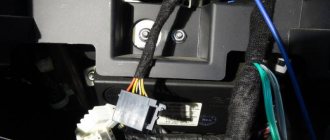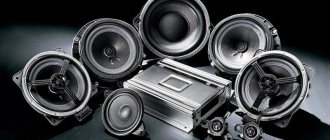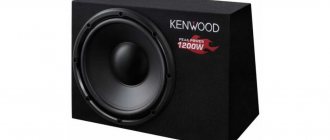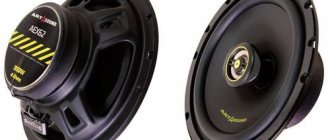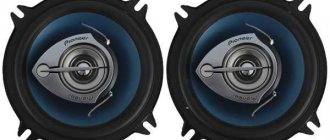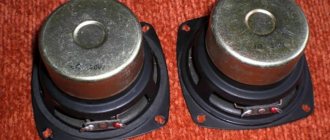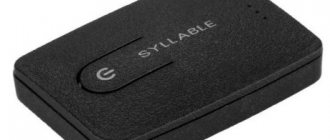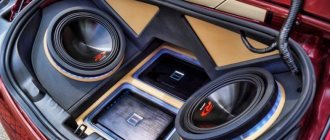Articles
- 2 Coaxial or component
- 3 Review of famous and best midbass speakers
- 4 Car audio frequencies you need to know about
Mid-bass acoustics budget
Midbass acoustics is a classification based on the frequency range. She always takes one bass (mid), working in the range of her own frequencies. Part of component acoustics. Let's take a closer look at it.
Types of acoustics
To create high-quality sound in the car, three types of acoustic elements are used:
- High-frequency speakers - tweeters. These are small “tweeters” that are capable of reproducing only high frequencies - from 5 to 20 thousand hertz. They are best used in the front part of the car, for example, on the A-pillars. In tweeters, the membrane is rigid because sound vibrations do not travel a long distance from the center of the speaker;
- Coaxial acoustics – also called coaxial. Its peculiarity lies in the fact that such acoustics belong to the category of a universal solution. Such speakers have both high- and low-frequency drivers in one housing. The result is loud, but the quality is noticeably lower if the motorist creates component acoustics;
- Low frequency speakers - subwoofer. Such devices are capable of transmitting sounds with a frequency of 10 to 200 Hz. If you use a separate high- and low-frequency speaker through a crossover, the sound of the composition is much clearer, and the bass does not mix with the high frequencies. For a bass speaker to work, a soft membrane is required and, accordingly, a large size so that it works in swing.
Fans of high-quality car audio are converting broadband acoustics (standard sound that comes with the car from the factory) to component ones. The second option will require an additional crossover.
However, no matter how high-quality the acoustics are, if you do not properly prepare the place for its installation, the sound quality will not differ much from standard loud wideband speakers.
Car audio frequencies you need to know about
So, let us recall that the entire sound spectrum is usually divided into three main parts: low frequency, midrange and high frequency. The midbass zone in this case is the midrange or midrange frequencies.
Features of sound registers
Frequency limits can be divided as follows:
- Low frequencies are reproduced within 10-220 Hz;
- The midrange or midbass zone varies between 200 Hz-5 kHz;
- Anything above this limit is considered to be high-frequency or bass.
But the information presented above cannot be accurate, as it represents only a superficial understanding of the sound spectrum. To familiarize yourself with the sound spectrum in more detail, we recommend that you study the data below.
- Experts highlight such a thing as low bass. In this case we are talking about sounds that live in the range of 10-80 Hz. The entire car interior resonates from such sounds. Without these bass, musical works, especially rock compositions, will lose richness, brightness and depth of sound.
- It is customary for experts to distinguish between high basses, which live in the range of 80-200 Hz. These are the classic top notes produced by all bass instruments. Without this sound register, the sense of sound power is lost.
- Low mids. There is also such a register, which lives in the range of 200-500 Hz. It's all rhythm and accompaniment of sound. Considered the classic register of the guitar.
- Midrange, living in the range of 500-2500 Hz. Musically, it's solo and vocals. Without this register, the sound will lose a lot and seem somewhat colorless and boring.
- The upper midrange lives between 2500 Hz-5 kHz. Although there are few notes in this register, selected piano sounds sound in this range. Without these notes, the music will lose harmonics and overtones. But with them, musical compositions will receive the effect of presence, bright sound and much more.
- Low HF, living in the 5-10 kHz register. This is where the strongest distortions are observed. It is considered the highest tone, the highest limit of perception.
- Upper HF in the 10-20 kHz register. The very last octave is concentrated here. The finest, soft-crystal sounds are output through this range.
You can learn more about midbass acoustics from photos and videos.
What does car acoustics consist of?
A car speaker system may include a large number of components that need to be connected correctly in order to enjoy the purity of musical compositions. For many motorists, the acoustics in a car mean a car radio and a couple of speakers.
It's actually just a sound-producing device. Real acoustics require the correct selection of equipment, installation location and compliance with sound insulation requirements. The sound quality of expensive equipment depends on all this.
Here are the key elements that make up effective car audio.
Crossover (pass filter)
As the name suggests, this device is designed to split an audio stream into different frequencies. Externally, the crossover is a box with various electrical parts soldered on a board.
This device is installed between the amplifier and speakers. There are passive and active crossovers. Each of them has its own advantages and disadvantages, and they have different frequency separation effects.
2. Amplifier
This is another device that looks like a box installed between the car radio and the speakers. It is designed to amplify the sound signal. But if a motorist is not a music lover, and he needs a radio to create a general background in the car, then buying an amplifier is a waste of money.
An amplifier makes the sound more powerful, cleaner and better quality. This device is for those for whom not just the music is important, but its purity - so that he can clearly recognize the sound of a vinyl recording.
Before buying an amplifier, you need to correctly calculate its power (it must correspond to the capabilities of the speakers and the size of the car interior). If the car has weak speakers, then installing an amplifier will only lead to a rupture of the diffuser. The power of the amplifier is calculated based on the power of the speakers (or subwoofer). Its maximum should be 10-15 percent less compared to the peak power of the speakers.
In addition to power (the effect of this device will be if this parameter is at least 100 watts), you need to pay attention to the following parameters:
- Frequency range. It should be at least 30-20 thousand Hertz.
- Background level is within 96-98 dB. This indicator minimizes the noise level between tracks.
- Number of channels. Particular attention should be paid to the connection diagram of the acoustics with the subwoofer. It would be nice if the amplifier had a separate channel for it.
3. Subwoofer
This is a speaker that reproduces low frequencies. The key parameter for choosing this component is its power. There are passive (without a built-in amplifier) and active (with an individual built-in amplifier) subwoofers.
In order to fully use the subwoofer so that it does not drown out the work of the other speakers, it is necessary to correctly organize the distribution of sound waves on the front and rear speakers. To do this you can:
- Make an endless screen (the subwoofer is mounted in the rear shelf). In this design, there is no need to make any calculations regarding the dimensions of the box, and the speaker is easy to install. At the same time, the bass quality is at its maximum. The disadvantages of this method include distortion of the subwoofer sound when the car trunk is filled differently. Also, to prevent damage to the speaker, it is necessary to use a “Sabsonic” filter.
- Install a bass reflex. This is a closed box in which a tunnel is made. This method has more disadvantages than the previous one. So, you need to make the correct calculations on the size of the box and the length of the tunnel. The design also takes up a lot of space in the trunk. But if everything is done correctly, then the sound distortion will be minimal, and the low frequencies will be given maximum effect.
- Install simply closed boxes. The advantage of this design is that it protects the speaker from impacts, as well as ease of installation. This reduces the efficiency of the subwoofer, which is why it is better to buy a more powerful amplifier and subwoofer.
4. Speakers
There are component and coaxial car speakers. In the first case, for the sake of sound quality, you will have to make certain sacrifices - you will need to redo the interior of the car (you need to install not two speakers on the sides of the shelf, but determine a place for several speakers). For example, to install three-way acoustics, you will have to look for space for six speakers. Moreover, they need to be installed correctly so that they do not interfere with each other.
If we talk about broadband speakers, then it is enough to install them on the rear shelf near the glass. There is no place for full-size component acoustics there, because, firstly, they should not reproduce low frequencies. Secondly, it must create surround sound, which cannot be achieved when reflected from glass (the sound will be directional).
What is midbass?
If you are about to improve the car audio in your car, do it wisely. If you start making hack work, you yourself will have to suffer later. But we digress.
So, midbass. These speakers are needed to transmit mid-frequency bass, from 80 to 400 Hz. They are an integral part of component car audio systems.
Typically, midbass speakers are located in the front of the car, in the doors. Tweeters are placed on the dashboard or A-pillars: they are responsible for the range of 5,000-20,000 Hz. The connection point for the subwoofer is the rear acoustic shelf . Its frequency maximum is 50-60 Hz. For midrange drivers, it doesn’t matter where they stand, on the rear shelf or in the doors.
The most popular woofer speaker sizes are 16 and 20 cm, but there are also 10 and 13 cm. The larger the diameter, the lower frequencies become available. High-quality midbass acoustics should have high performance in the following characteristics:
- frequency coverage;
- speaker power (N – minimum indicator, P – upper limit);
- sensitivity (the higher the resistance, the lower the power, but the clearer the sound).
Of course, without high-quality materials there can be no talk of good acoustics. The fewer resonating elements, the less rattling. When installing speakers, take care of the seals.
Door damping
Since the shape of a car door is uneven, sound waves are reflected from it in their own way. In some compositions this is critical, as the music may be mixed with the reflected sound waves. For this reason, you should properly prepare the place for installing the speakers.
To eliminate this effect, quality car audio installers recommend using soft material that will absorb vibrations, preventing them from spreading inside the door. However, given the different structure of its surface, either a soft or hard substrate should be used. If you lightly knock on the door, where the sound will be duller, you should stick a soft damping material. In other places it is hard.
This procedure is very important, since the door in the car is always hollow, so it works like a resonator in a guitar. Only in the case of car acoustics this does more harm to the beauty of the sound than it makes the music more enjoyable.
But even in the case of sound insulation, one should not be overzealous. If you install completely sound-absorbing panels, the music will be muffled, which will immediately become noticeable for a music lover. Let's look at how to make a high-quality sound-reflecting screen.
Door vibration suppression circuit
To determine which part of the doors needs a damper screen installed, you need to knock on the outside of the doors. In those places where the sound will be louder and more distinct, you need to stick on hard noise insulation. Where the sound is duller, stick on soft noise insulation.
But soundproofing the steel part of the door will still not completely eliminate the resonance effect during speaker operation. If the inside of the door resonates, the music will not be heard clearly. It will appear that the speaker is installed in a large speaker.
But on the other hand, you should not overdo it with the installation of sound-absorbing elements. Excessive sound absorption is also fraught with poor sounding acoustics. Some sound waves will lose volume.
The sound screen should consist of two parts (in addition to soundproofing the doors). One part (a sheet of approximately 30*40 centimeters) must be glued immediately behind the speaker, and the other - at the maximum distance from it. As an acoustic damper, it is better to choose a material that does not absorb moisture, because water can get into it from under a worn glass seal.
Form factors
One of the determining parameters is the size or form factor. On sale you can find midrange speakers designed for 10 cm, 13 cm, 16 cm and 20 cm. The most powerful of these will be the 20 cm midbass. However, this parameter also depends on a number of characteristics, namely on the manufacturer and its achievements in the field of acoustics.
The size is generally determined not by the desire to choose one speaker or another, but by the installation location. This statement is obvious, and sometimes you can come across similar questions: “Is it possible to install a smaller size, but with improved characteristics?” This can probably be done in a way that violates aesthetics, but there is no need to complicate the process.
To select suitable speakers, check your installation locations and, accordingly, the diameters of the midbass you need. Usually there are standard speakers that can be changed if necessary. Moreover, the type and nature of the installed system largely depends on the vehicle itself. The Volkswagen crossover will have more advanced acoustics than the VAZ. At the same time, do not underestimate the same Ural, which is installed in the door, in front and behind the cabin.
Kicx PRO 6020
Acoustic screen in the door
The screen is most needed for speakers with high and mid frequencies. The main purpose of using the screen is to provide the clearest and at the same time deep bass. The optimal playback range for such a speaker should be at least 50Hz.
There are two options for acoustic screens:
- Internal - the material is installed under the door card;
- External - a special box is made in which the loudspeaker is located. It is attached on top of the door card.
Each option has its own advantages and disadvantages.
Internal acoustic screen
Pros:
- There is no need to damage the door card, which preserves the interior of the car;
- All elements of the internal screen are hidden under the casing, so there is no need to perform any decorative work for the speakers to not only sound beautiful, but also look decent;
- A powerful speaker will be held more securely, which will allow it to be “swinged” more strongly.
Minuses:
- The speaker will look like a standard speaker. If the emphasis is not only on the beauty of the music, but also on external changes, then it is worth using an external screen;
- The bass won't be as bouncy;
- In such a screen, the loudspeaker will be installed in only one position. Often standard equipment directs the sound wave from the speaker to the feet. This screen option will not allow you to change the tilt angle of the column.
So where should you install midbass speakers?
As a rule, midbass speakers are installed in the front doors, but when installing the speakers, you should not forget about the seals to avoid rattling from resonating elements. It is best to install the midbass in a specialized podium, and cover the inside of the door with material for car sound insulation.
In any case, if you decide to install component acoustics in your car, if you like to listen to really high-quality music while traveling, revealing all the warmth and versatility of the sound, you often cannot do without midbass.
External acoustic screen
Pros:
- Since a significant part of the screen is located outside the door card, there are many more ideas for implementing different design solutions than in the previous version;
- Inside the screen, some of the sound waves are absorbed, and the desired sound is reflected, making the sound cleaner and the bass deeper;
- The column can be directed in any direction. Car audio enthusiasts often configure their speakers so that most of the sound waves are directed toward the top of the cabin.
Minuses:
- Since the speaker will be attached to the outside of the screen, the case must be as durable as possible;
- It will take time to create the design, as well as money to purchase additional material;
- If you don’t have the skills to install speakers, you can not only ruin the sound, but also break the speaker itself (in addition to the fact that it itself vibrates when the sound is loud, the vibrations intensify while driving, which is why the membrane can quickly tear);
- A certain angle of inclination is required.
Advantages and disadvantages
If you “forget” about midbass, you will get a huge sound gap when playing music. That is, the octave simply cannot be heard. Let's list what midbass brings with it:
Without the woofer, the music sounds like a “bang-bang”, with squeaky voices of the singers.
It would be unfair not to mention the shortcomings.
- Firstly, the price. A branded speaker costs around $300, although there are cheaper options.
- When installed in a door, an acoustic short circuit is possible if the fastening is not secured.
- Without purchasing an amplifier, you will not achieve sound effects.
An acoustics connoisseur will turn any negative into a positive, just to enjoy the rich sound.
Sound emission angle
If the speaker is placed too high, it will affect the clarity of the music. High frequencies will be transmitted worse. Experience shows that tilt angles greater than 60 degrees distort the transmission of the audio signal. For this reason, when creating an external screen, this value should be accurately calculated.
When making the outer structure, you first need to securely fasten the inner screen. Then the outer box is either initially made with the desired slope to the vertical, or screwed obliquely with self-tapping screws. The voids are filled with putty. The entire structure is processed with fiberglass and covered with appropriate fabric.
Connection process
The rear speakers are connected to the radio using a miniJack connector. If you have high-quality soldering skills, you can unsolder a suitable connector, which will facilitate the connection process.
If you connect one speaker, you can use the linear output, which is available in most radio tape recorders (minijack). When connecting more speakers, you need to buy splitters or, depending on the radio model (active or passive), connect directly to the connectors on the rear panel.
If the car radio does not have a built-in amplifier (most devices are equipped with a standard amplifier that can provide normal operation to conventional full-range speakers), then in order to drive the bass speakers, you need to purchase an additional amplifier and crossover.
Let's briefly consider the entire process of installing car speakers.
Preparatory stage
First, you need to lay out all the wiring correctly. It is better to combine this process with interior renovation. This way, the wires will not need to be laid in unsuitable areas of the cabin. If the wire connection is poorly insulated, it may come into contact with the car body and cause either leakage current or a short circuit.
When installing speakers in a door, it is necessary to correctly calculate their location in the door frame so that when the door is closed, the speaker housing is not pressed against the post. The wires between the moving elements are stretched so that when the door is closed they do not fray or get pinched.
Insulation Features
For high-quality insulation, do not use twists and tape. It is much more practical to use soldering or mounting strips (this ensures maximum contact between the wires). To prevent bare wires from contacting each other or the machine body, it is necessary to use casings. These are thin insulating hoses. They are put on the wires to be connected and, using high temperature (a match or lighter), are tightly seated at the junction.
This insulation method prevents moisture from penetrating the connection point (prevents the wires from oxidizing), as if it were inside factory insulation. For greater confidence, you can wrap electrical tape over the cambric.
We lay the wiring
It is better to lay the wires along the interior under the upholstery or in a special tunnel, to which there is access if the line needs to be repaired. To prevent the wires from chafing, rubber seals must be installed in the places passing through the drilled holes.
Wire marking
This is an important step that makes it easier to properly connect the wires. Especially if the car owner uses a cable of the same color. To avoid connection errors and ease of repair (or search for these errors), it is practical to use wires of different colors (one color per contact).
Connecting the speakers
If broadband speakers are used, then each of them is connected to the corresponding contact in the radio chip. To make this easier, the car radio manufacturer includes short installation instructions in the kit. It indicates the purpose of each contact.
Each speaker must not only connect correctly, but also have its own place in the cabin. All speakers have their own purpose and operating principle, which affects the quality of the music.
Final work
Before completing the work and hiding the wires under the casing or in the tunnel, it is necessary to test the system. The quality of editing is checked by playing various types of compositions (each of them has its own sound frequencies). You can also check whether the sides are mixed up by changing the balance level in the radio settings.
Recommendations
Comments 39
Hello! Please tell me, I’m changing the standard acoustics, now there is a spacing at the bottom of the midrange and at the top of the HF in all 4 doors. I bought a subwoofer for the trunk, I want to leave the treble as is and replace the midrange. I'm thinking of putting midrange in front and midbass in the rear doors. How correct is this?
Front doors for front passengers, rear doors for rear passengers. Ideally, the rear speakers in front should not interfere with listening at all. What is the size of the midrange in front? 16.5?
Ford Mondeo. Speakers 16.5 Each door has a separate tweeter and speaker. The HF seems to be playing normally, I think not to change it and leave it with the mafon, I’m afraid it will burn out with the amp. And the speakers are replacements. I just can’t decide which ones to put. Yesterday, before I bought Ural AK74 widebands so as not to bother, I went to a car audio studio, turned it on, and didn’t like it. They didn’t recommend taking them, they recommended pride events, but they don’t fit into my budget. The sub, as far as I understand, plays frequencies up to 40Hz. If I put only the score, especially the stage, then they are from 130Hz. There will be a hole
Sub up to 60Hz, set any 16.5 if the price suits you up to 5tr per pair, there’s nothing interesting at all. There will be more or less bass if the door is prepared. Didn’t you look at the URAL AS-W165MB?
So does it even make sense to install midbass in the rear doors? Or can we get by with just mid-frequency drivers?
I only have a sub in the back) for the driver only the front speakers are needed
I want things to be normal in the back too. They advise me to install mids and high frequencies everywhere. What do you think? I'm chasing quality. There is no need for yelling
Quality is a relative concept; if you put speakers behind you, the quality will be worse for the driver. An extra sound source will appear that cannot be coordinated with the front. Put what's in the back and what's in front and that's it
Well, I still need speakers in the back. Maybe stick some simple ones in there. What can you say about the seeds? And the layout of the lights in the front and the mids in the back?
Set the midbass, in the back if the staff doesn’t wheeze, then you don’t have to change it
Shtatka farts at 80 percent volume
Install something more powerful than a staff. And the standard one usually has 15-30W speakers and will fart by 50%. (If from a radio) Are the speakers at the bottom at 60Hz cut? And you need to understand that almost all radios cannot be turned up to the maximum. They can produce an already distorted signal which is amplified by the amplifier. The saying “everything is good in moderation” fits well here; on the radio, no more than 60-70%, and on the amplifier, Gain should also not be turned to maximum
I Dina will connect everything through VX. I plan to leave only the HF from the stock
If you want to save money, then put something cheaper in the back, it won’t work for front passengers anyway. The difference is what's behind there
Good afternoon. Approximately how many degrees should the midbass turn be? And where should the HF be installed?
professionally) but how did you manage to achieve such noise in the engine compartment that you can only hear it at 4000 rpm? I can even hear the idle on the basin, although it was also noisy, also on both sides
Svyatogor is good! I once drove one myself - a great car, if only it hadn’t rotted.
I recognize the midbass! Moreli virtus! Tell us the composition of this system and in detail at what frequency and in what order you installed the junction between the mid and high frequencies!
midbass, unfortunately or fortunately, was still advanced, at the time when Virtus took them they had not yet been invented)) I changed the included tweeters to Eton cx280. GU Clarion 788 Amplifiers Eton ecc500.4 midHF Audison LRX2.500 on a Kicker s12c2 sub The tweeters were cut to 3.15 12dbkt mids 3.15 18dbkt top and 63Hz 18dbkt bottom sub humped at 55Hz so it was decided to cut it 50Hz 12dbkt second option was cutting 63Hz 18dBoct and equalizer to suppress 50Hz.
How to position the speakers correctly?
The sound quality of acoustics directly depends on how firmly the speakers are secured. For this reason, the acoustic screen is made of wood. In the standard version, the beauty of sound begins to be felt when the weight of the entire structure is more than 7 kg. But to achieve maximum effect, an increase in the mass of the structure is welcome. The main thing is that the door hinges can withstand such weight.
When the screens are connected, there should be no gaps between them. Otherwise, the vibration of the speaker will separate the elements or they will start to rattle. An external screen cannot be installed without an internal one. The reason for this is that the music will not differ from the sound of conventional speakers.
As for self-tapping screws, they must be made of non-ferrous metal. Otherwise, they will be magnetized and distort the operation of the speaker.
Midbass speakers: to buy or not to buy for cars?
Proper installation of acoustics in a car ensures the full sound of musical instruments and the singer’s voice. To achieve the effect of maximum proximity to natural sound, it is necessary to install speakers of different frequencies:
- low-frequency (subwoofer, midbass speakers);
- midrange speakers;
- high (twitter).
But many believe that the mid-bass can be covered by a combination of subwoofer and midrange speakers and get an acceptable result at the output: it plays loudly, and that’s the main thing! Why this is not so, read below.
The best car audio
Here is a small TOP of the best car audio at an affordable price:
| Model: | Specifics: | Price: |
| Focal Auditor RSE-165 | Coaxial acoustics; tweeter inverted in a dome; protective steel grille | $56 |
| Hertz K 165 Uno | Speaker diameter – 16.5 cm; component modification (two-way audio separation); power (nominal) 75W. | 60 dollars |
| Pioneer TS-A1600C | Component two-way; diameter of woofers – 16.5 cm; power (nominal) 80W. | $85 |
Of course, there is no limit to either the size or volume of car acoustics. There are craftsmen who, with the help of a couple of additional batteries, a powerful amplifier and huge speakers, can easily organize a rock concert in their Lada, which can cause the windows to fly out. In this review, we looked at recommendations for those who like beautiful, but not prohibitively loud sound.
Here is a short video comparison of coaxial and component acoustics for cars:
COMPONENT or COAXIAL? Which acoustics to choose!
Review of famous and best midbass speakers
Select car speakers
Let's now look at the most popular mid-bass speakers to get more information about their capabilities. Many car audio connoisseurs have heard of the manufacturer Morel. Well, it produces some of the best mid-bass speakers.
For example, the Dotech Ovation 6W model:
- It is sold here at a price of 6.6 thousand rubles, which is considered inexpensive.
- In addition, the model has a good and convenient size – 6.5 inches.
- Ferrite elements with a ventilation system are used as magnets, which has a very effective effect on the operation of loudspeakers.
- Voice coil 54 mm.
- The midrange diffuser is made of a special type of material – composite honeycomb fiber.
- The installation depth is small, which makes installation easy.
Let's go through the technical capabilities:
| Equivalent volume (Vas) | 13l |
| Diffuser self-resonance frequency (Fs) | 65 Hz |
| Mechanical quality factor (Qts) | 5,6 |
| Total quality factor (Qts) | 1,09 |
| Maximum mechanical movement (peak to peak) | 8 mm |
| Electrical quality factor (Qes) | 1,35 |
| Diffuser area (Sd) | 119 cm2 |
| Active winding resistance | 3.5 ohm |
| Inductance indicator | 0.21 kHz |
| Peak Power (P) | 300W |
| Rated power (N) | 140W |
| Frequency | 40Hz-4000Hz |
| Sensitivity | 90 dB |
| Nominal resistance | 4Ohm |
| Speaker size | 6.5 inches |
| Weight | 600 grams |
Component acoustics of the Audio System, which includes quite decent midbass.
- It is considered car acoustics for true connoisseurs of loud sound.
- Ideally combines high quality and clear sound.
- Virtually no distortion.
| N power | 2x120 W |
| P power | 2x180W |
| Diffuser material | Kevlar |
| Voice coil diameter | 32 mm |
| Installation depth | 58 mm |
| Speaker size | 130 mm |

